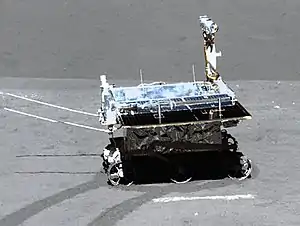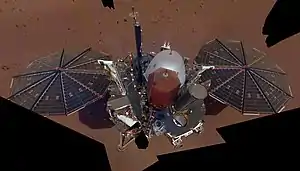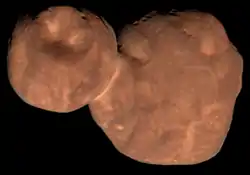Yutu-2
Yutu-2 is a robotic lunar rover that formed part of the Chinese Chang'e 4 mission to the Moon. It was launched on 7 December 2018, 18:23 UTC. It entered lunar orbit on 12 December 2018, before making the first-ever soft landing on the Moon's far side on 3 January 2019, and is currently operational as the first lunar rover on the far side.
 Yutu-2 rover | |
| Mission type | lunar rover |
|---|---|
| Operator | CNSA |
| Mission duration | 3 months (planned)[1] Current: 764 days |
| Spacecraft properties | |
| Launch mass | Rover: 140 kg[2] |
| Landing mass | 140 kg |
| Dimensions | 1.5 × 1.0 × 1.0 m[3] |
| Start of mission | |
| Launch date | 7 December 2018, 18:23 UTC[4] |
| Rocket | Long March 3B[5][6] |
| Launch site | Xichang Satellite Launch Center |
| Lunar rover | |
| Landing date | 3 January 2019, 02:26 UTC[7] |
| Landing site | Von Kármán crater in the South Pole-Aitken Basin |
| Distance covered | 565.9 m (1,857 ft) as of 25 October 2020[8] |
As of 25 October 2020, the rover had traveled a distance of 565.9 metres (1,857 ft) along the surface of the Moon.[8]
Overview
The total landing mass is 1,200 kg (2,600 lb).[2] Both the stationary lander and Yutu-2 rover are equipped with a radioisotope heater unit (RHU) in order to heat their subsystems during the long lunar nights,[9] while electrical power is generated by solar panels.
After landing, the lander extended a ramp to deploy the Yutu-2 rover (literally: "Jade Rabbit") to the lunar surface.[10] The rover measures 1.5 × 1.0 × 1.0 m (4.9 × 3.3 × 3.3 ft) and has a mass of 140 kg (310 lb).[2][3] Yutu-2 rover was manufactured in Dongguan, Guangdong province; it is solar-powered, RHU-heated,[9] and it is propelled by six wheels. The rover's nominal operating time is three months,[1] but after the experience with Yutu rover in 2013, the rover design was improved and Chinese engineers are hopeful it will operate for "a few years."[11]
Science payloads
- Panoramic Camera (PCAM), is installed on the rover's mast and can rotate 360°. It has a spectral range of 420 nm–700 nm and it acquires 3D images by binocular stereovision.[12]
- Lunar penetrating radar (LPR), is a ground penetrating radar with a probing depth of approximately 30 m with 30 cm vertical resolution, and more than 100 m with 10 m vertical resolution.[12]
- Visible and Near-Infrared Imaging Spectrometer (VNIS), for imaging spectroscopy that can then be used for identification of surface materials and atmospheric trace gases. The spectral range covers visible to near-infrared wavelengths (450 nm - 950 nm).
- Advanced Small Analyzer for Neutrals (ASAN), is an energetic neutral atom analyzer provided by the Swedish Institute of Space Physics (IRF). It will reveal how solar wind interacts with the lunar surface, which may help determine the process behind the formation of lunar water.[13]
Cost
The cost of the entire mission was close to building one kilometer of subway. The cost-per-kilometer of subway in China varies from 500 million yuan (about 72.6 million U.S. dollars) to 1.2 billion yuan (about 172.4 million U.S. dollars), depending on the difficulty of construction. [14]
Landing site
The landing site is within a crater called Von Kármán[15] (180 km or 110 mi diameter) in the South Pole-Aitken Basin on the far side of the Moon that was still unexplored by landers.[16][17] The site has symbolic as well as scientific value. Theodore von Kármán was the PhD advisor of Qian Xuesen, the founder of the Chinese space program.[18]
The landing craft touched down at 02:26 UTC on 3 January 2019, becoming the first spacecraft to land on the far side of the Moon.[19] Yutu-2 rover was deployed about 12 hours after the landing.[20]
Operations and results

A few days after landing, Yutu-2 went into hibernation for its first lunar night and it resumed activities on January 29, 2019 with all instruments operating nominally. During its first full lunar day, the rover travelled 120 m (390 ft), and on 11 February 2019 it powered down for its second lunar night.[21][22] In May 2019, it was reported that Chang'e 4 has identified what appear to be mantle rocks on the surface, its primary objective.[23][24][25]
In December 2019, Yutu 2 broke the lunar longevity record, previously held by the Soviet Union's Lunokhod 1 rover,[26] which operated on the lunar surface for eleven lunar days (321 Earth days) and traversed a total distance of 10.54 km (6.55 mi).[27]
In February 2020, Chinese astronomers reported, for the first time, a high-resolution image of a lunar ejecta sequence, and, as well, direct analysis of its internal architecture. These were based on observations made by the Lunar Penetrating Radar (LPR) on board the Yutu-2 rover while studying the far side of the Moon.[28][29]
References
- China says it will launch 2 robots to the far side of the moon in December on an unprecedented lunar exploration mission Archived 9 December 2018 at the Wayback Machine. Dave Mosher, Business Insider. 16 August 2018.
- Chang'e 3, 4 (CE 3, 4) Archived 20 March 2018 at the Wayback Machine. Gunter Dirk Krebs, Gunter's Space Page.
- This is the rover China will send to the 'dark side' of the Moon Archived 31 August 2018 at the Wayback Machine. Steven Jiang, CNN News. 16 August 2018.
- "CNSA". China National Space Administration (in Chinese). Archived from the original on 10 December 2018. Retrieved 8 December 2018.
- Chang'e-4: Far side of the Moon lander and rover mission to launch in December Archived 18 June 2018 at the Wayback Machine. Global Times, 18 June 2018.
- Launch Schedule 2018 Archived 16 August 2018 at the Wayback Machine. SpaceflightNow, 18 September 2018.
- Barbosa, Rui (3 January 2019). "China lands Chang'e-4 mission on the far side of the Moon". Nasaspacefight. Archived from the original on 3 January 2019. Retrieved 3 January 2019.
- "China's lunar rover travels 565.9 meters on moon". China Internet Information Center. 25 October 2020. Retrieved 8 November 2020.
- China Shoots for the Moon's Far Side. (PDF) IEEE.org. 2018.
- Xu, Luyuan (15 June 2018). "How China's lunar relay satellite arrived in its final orbit". The Planetary Society. Archived from the original on 17 October 2018.
- China's Chang'e 4 spacecraft to try historic landing on far side of Moon 'between January 1 and 3' Archived 2 January 2019 at the Wayback Machine. South China Morning Post. 31 December 2018.
- The scientific objectives and payloads of Chang'E−4 mission. (PDF) Yingzhuo Jia, Yongliao Zou, Jinsong Ping, Changbin Xue, Jun Yan, Yuanming Ning. Planetary and Space Science. 21 February 2018. doi:10.1016/j.pss.2018.02.011
- Andrew Jones (16 May 2016). "Sweden joins China's historic mission to land on the far side of the Moon in 2018". GBTimes. Retrieved 12 January 2018.
- http://www.ecns.cn/m/news/sci-tech/2019-07-31/detail-ifzmnmiq8702425.shtml
- China's Journey to the Lunar Far Side: A Missed Opportunity? Paul D. Spudis, Air & Space Smithsonian. 14 June 2017.
- Ye, Peijian; Sun, Zezhou; Zhang, He; Li, Fei (2017). "An overview of the mission and technical characteristics of Change'4 Lunar Probe". Science China Technological Sciences. 60 (5): 658. doi:10.1007/s11431-016-9034-6.
- "China Plans First Ever Landing on the Lunar Far Side". Space Daily. 22 May 2015. Archived from the original on 26 May 2015. Retrieved 26 May 2015.
- "Hsue-Shen Tsien". Mathematics Genealogy Project. Archived from the original on 9 December 2018. Retrieved 7 December 2018.
- "Chang'e 4: China probe lands on far side of the moon". The Guardian. 3 January 2019. Archived from the original on 3 January 2019. Retrieved 3 January 2019.
- Chang'e-4: Chinese rover now exploring Moon Archived 4 January 2019 at the Wayback Machine. Paul Rincon, BBC News. 4 January 2019.
- Jones, Andrew (11 February 2019). "Chang'e-4 powers down for second lunar night". SpaceNews. Retrieved 1 August 2019.
- Caraiman, Vadim Ioan (11 February 2019). "Chinese Lunar Probe, Chang'e-4, Goes Standby Mode For The Second Lunar Night on The Dark Side of The Moon". Great Lakes Ledger. Retrieved 1 August 2019.
- Ouyang, Ziyuan; Zhang, Hongbo; Su, Yan; Wen, Weibin; Shu, Rong; Chen, Wangli; Zhang, Xiaoxia; Tan, Xu; Xu, Rui (May 2019). "Chang'E-4 initial spectroscopic identification of lunar far-side mantle-derived materials". Nature. 569 (7756): 378–382. Bibcode:2019Natur.569..378L. doi:10.1038/s41586-019-1189-0. ISSN 1476-4687. PMID 31092939.
- Strickland, Ashley (2019-05-15). "Chinese mission uncovers secrets on the far side of the moon". CNN. Retrieved 2019-05-16.
- Rincon, Paul (15 May 2019). "Chang'e-4: Chinese rover 'confirms' Moon crater theory". BBC News. Retrieved 1 August 2019.
- China's Farside Moon Rover Breaks Lunar Longevity Record. Leonard David, Space.com. 12 December 2019.
- Howell, Elizabeth (December 19, 2016). "Lunokhod 1: 1st Successful Lunar Rover", Space.com. Retrieved May 31, 2018.
- Chang, Kenneth (26 February 2020). "China's Rover Finds Layers of Surprise Under Moon's Far Side - The Chang'e-4 mission, the first to land on the lunar far side, is demonstrating the promise and peril of using ground-penetrating radar in planetary science". The New York Times. Retrieved 27 February 2020.
- Li, Chunlai; et al. (26 February 2020). "The Moon's farside shallow subsurface structure unveiled by Chang'E-4 Lunar Penetrating Radar". Science Advances. 6 (9). doi:10.1126/sciadv.aay6898. Retrieved 27 February 2020.




